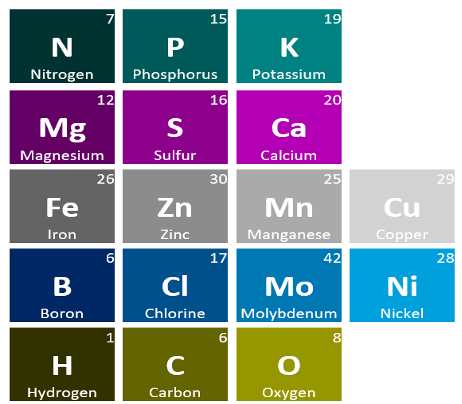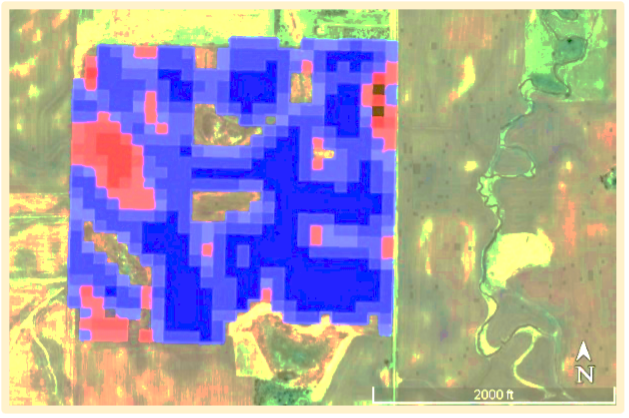Written collaboratively by Ali Mirzakhani Nafchi, Assistant Professor & SDSU Extension Precision Agriculture Specialist, Jason Clark, Assistant Professor & SDSU Extension Soil Fertility Specialist and Salman Mirzaee.

To maximize growth and productivity, plants require 17 different nutrients (Figure 1). Some of these nutrients (carbon (C), hydrogen (H), and oxygen (O)) are obtained from water and/or the atmosphere. The remaining 14 essential nutrients are absorbed from the soil and are classified as macro or micronutrients based on the amount needed by plants. Macronutrients are needed in concentrations of 1000 µg g-1 of dry matter or more, whereas micronutrients are needed in concentrations equal to or less than 100 µg g-1 of dry matter. The macronutrients are Nitrogen (N), Phosphorus (P), Potassium (K), Calcium (Ca), Magnesium (Mg) and Sulfur (S). The micronutrients needed by plants are Iron (Fe), Zinc (Zn), Copper (Cu), Manganese (Mn), Boron (B), Chloride (Cl), Molybdenum (Mo), and Nickel (Ni). When corn plants have sufficient quantities of the macro- and micro-nutrients, they are typically a dark green color (Figure 2.)

Soil sampling is a common method to determine if plant essential nutrients are in sufficient quantities. Soil samples are collected from the field and sent to a lab for analysis of the nutrient content. The soil lab reports can tell us if these nutrients are in sufficient quantities for optimum plant growth and development or if supplemental nutrients are needed. Based on these reports, a recommended fertilizer program is applied to the field. In addition to preplant soil testing, in-season crop monitoring for nutrient deficiency symptoms during the season is important to determine if any nutrients are below sufficiency for the crop. Monitoring the crop can be done one of two ways. First, the traditional method is to physically walk through fields and look for visual nutrient deficiency symptoms. Second, precision agriculture tools like drones, canopy sensors, and satellites can be used to take pictures and assess if nutrient deficiencies exist. This article will briefly introduce these two methods of 1) visually identifying corn nutrient deficiency symptoms and 2) using precision agriculture technologies that can be used to identify nutrient deficiency symptoms.
Method I: Identifying Visual Nutrient Deficiency Symptoms
It is important to know what visual symptoms look for when scouting fields for nutrient deficiencies. The general types of nutrient deficiency symptoms include:
- Chlorosis (yellowing) of leaves in a uniform pattern or interveinal often referred to as striping.
- Necrosis, or death, of plant tissue.
- Plant tissue turning a red or purple in color.
- Stunting of plant growth.
- Lack of new growth.
Where these nutrient deficiency symptoms appear on the plant can also determine what nutrient might be causing the symptom. Mobile nutrient (N, P, K, and Mg) deficiencies normally appear in older leaves since these nutrients are mobilized from older to newer leaves to maintain plant growth. Non-mobile nutrient (Zn, S, Ca, B, Fe, Mn, Cu, Mo, Cl) deficiencies appear in newer leaves first since these nutrients are not easily moved from older to newer leaves. Visual symptoms for each of the essential nutrients are described below. It is important to note that other conditions including herbicide injury, soil compaction, root pruning, and pests can cause symptoms that mimic nutrient deficiency symptoms. Therefore, plant tissue tests in combination with soil tests can be used to determine if a true nutrient deficiency exists.
Visual nutrient deficiency symptoms
Calcium:
Ca deficiency appears on younger leaves with light green or whitish spots on tips of corn and leaf tips stick to the next lower leaf and may be severely stunted.

Iron:
Fe is immobile and its deficiency appears as chlorosis on younger leaves to become pale green to yellow.

Manganese:
Mn deficiency appears on newly emerged leaves that become olive green and may become slightly streaked.

Boron:
B deficiency appears on younger leaves with stunted growth and either yellow or white spots.

Sulfur:
S deficiency appears as a light green to yellowish striping on younger leaves.
 Zinc:
Zinc:
Zn deficiency appears on the upper plant canopy with interveinal striping at the base of the leaf and extending to the tip. Corn plants are stunted due to shortened internodes.

Copper:
Cu deficiency appears as the youngest leaves are yellow as the emerge from the whorl and leaf tips die back and are twisted.

Nitrogen:
N deficiency appears as initial chlorosis at the tip and spreads to the middle of older leaves.

Potassium:
K deficiency appears as chlorosis and necrosis along tips and margins of older leaves.

Phosphorus:
P deficiency appears reddish-purple on older leaves and stems especially on young plants.

Magnesium:
Mg deficiency appears on lower leaves as interveinal striping becoming necrotic purplish of older leaves.

Drought stress:
Drought stress symptoms are leaves rolling up to the size of a pencil with grayish-green color.

Diseases:
Diseases may create small spots that gradually spread across the leaf.

Chemicals:
Chemical damages are burned tips and edges, necrotic spots, and whitecap leaves.

Method II: Precision Agriculture Technologies Used in Identifying Nutrient Deficiency Symptoms

Determining nutrient deficiencies by using only visual and plant testing methods is time-consuming, difficult, and costly. Precision agriculture technologies can be used to detect nutrient deficiencies earlier in the season and scout large field areas more efficiently. These tools include remote sensing data, crop canopy sensors, such as GreenSeeker, and multispectral sensors mounted on drones (Figure 3). For example, the spectral information collected by satellites or drones can be used to detect nutrient deficiency symptoms before they are visible to the human eye. This earlier detection of a nutrient deficiency increases the chance that the application of nutrients can be conducted before yield is reduced.

Dividing fields into management zones and using canopy sensors to map fields is another precision ag tool that can be used to manage nutrient applications more precisely (Figure 4). These zones can be based on factors including topography, soil test information, soil sensors, crop canopy sensors, and satellite information. The information for each zone can then be used to adjust the fertilizer rate throughout the field. Using these precision ag tools has the potential to help us identify and correct nutrient deficiencies earlier in the season that can result in an increase in economic profit and minimize potential negative environmental effects from excess fertilizer applications. Overall, these precision ag tools can be used to help farmers gather, process, and analyze information that can then be used to improve the accuracy of crop nutrient management practices.
References
- International Plant Nutrition Institute. 2011. Nutrient source specifics series. 10 Sept. 2011.
- Marschner, P. 2012. Marschner's Mineral Nutrition of Higher Plants. Academic Press.
- University of Minnesota Extension
- Sawyer, J. 2004. Nutrient deficiencies and application injuries in field crops. In Integrated pest management. IPM 42. Iowa State Extension. Ames, IA.


